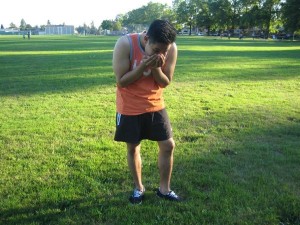Nosebleeds involves damage in the blood vessels in the nose. Nosebleeds can be caused by drying of the nasal membranes and picking of the nose. This can be prevented by proper lubrication of the nasal passages.
Children between ages 2-10 years old are usually prone to nosebleeds caused by falling or injuries while running or playing. In addition, children squabbling with each other and elderly at 50 years old and above are also prone to frequent episodes.
The severity depends on various factors such as the area where the bleeding originated. Bleeding that originated from the front of the nose is called an anterior nosebleed and bleeding from the rear of the nose is called as posterior nosebleed.
What are the symptoms?

- The need to swallow frequently caused by a blocked sensation in the nasal passages
- Presence of blood from either one or both nostrils
- A sensation of a fluid at the back of the nose and throat
- Difficulty breathing and sensation of choking
- Reddish-brown powdery substance on tissue paper when wiping the nose.
- Nasal deformity
- Dizziness or lightheadedness
- Hearing problems
- Bleeding gums
- Fever and chills
- Seizures
- Swelling around the cheeks and nose
- Vomiting
Causes of nosebleeds
- Excessive exposure to warm and dry air for long periods of time
- Allergic rhinitis
- Tumors in the nasal passages
- Foreign objects that are stuck in the nasal passages
- Nasal or sinus infections
- Blowing the nose vigorously and sneezing excessively
- Chemical irritants such as ammonia
- Common cold
Treatment
- Sit up straigth and tilt the head slightly forward. Using the thumb and the index finger, pinch the soft area of the nose just below the bony bridge for at least 5-10 minutes and breathe via the mouth. Release the pressure and rest for 5 minutes. If the bleeding still continues, repeat the process until bleeding settles.
- Apply an ice pack on the affected area to lessen the swelling and bleeding. The cold reduces the flow of blood and causes it to clot faster and stops bleeding in a few minutes. Avoid applying the ice pack directly on the nose. Wrap the pack in a towel or small piece of cloth. If an ice pack is not available, place ice cubes in a plastic bag and wraps with a towel and place it on the affected nose.
- Elevate the affected area until the bleeding stops. When lying down, elevate the head using a couple of pillows or sitting in a reclining chair with the head above the rest of the body. Avoid bending over to prevent flowing out of blood in the nose.
- If an individual is susceptible to nosebleeds, inhale steam as much as possible. If it does not stop the flow of blood in the nose within 20-30 minutes, seek medical help immediately.
Disclaimer
The material posted on this page for nosebleeds is for learning purposes only. If you have a severe nosebleed consult your local physical. If you want to learn to properly manage external bleeding including nosebleeds, register for a first aid course with a training provider near you.
FACT CHECK
https://www.webmd.com/first-aid/nosebleeds-causes-and-treatments
https://www.healthline.com/symptom/nosebleed
https://www.nhsinform.scot/illnesses-and-conditions/ears-nose-and-throat/nosebleed